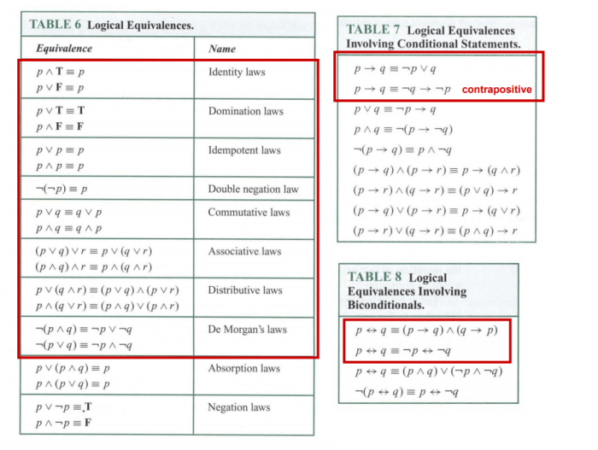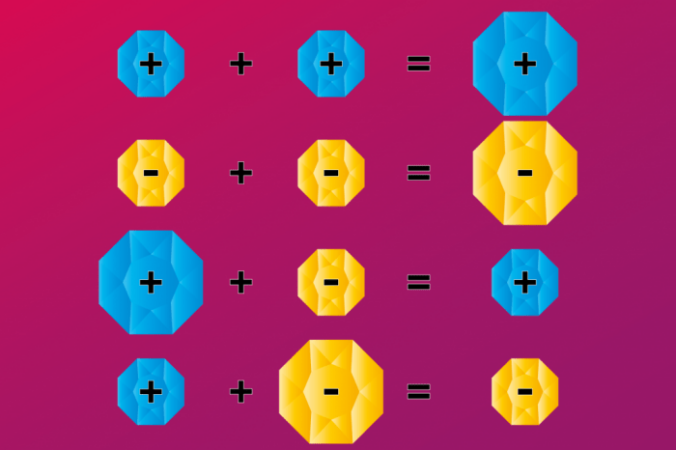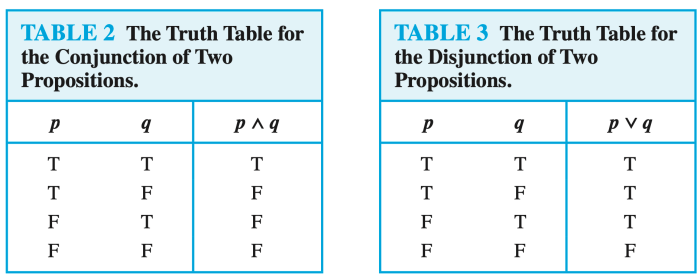
De Morgan’s Law, a fundamental principle in logic, unveils a fascinating relationship between logical operations. Discovered by the renowned mathematician Augustus De Morgan, these laws offer a powerful tool for simplifying complex logical expressions and manipulating sets. They elegantly demonstrate how the negation of a conjunction (AND) is equivalent to the disjunction (OR) of the negations, and vice versa. This principle, often referred to as the “dual” of logical operations, finds applications in diverse fields, from set theory and Boolean algebra to computer science and artificial intelligence.
The beauty of De Morgan’s Law lies in its ability to transform complex logical statements into simpler, more manageable forms. This simplification process is crucial in various disciplines, enabling efficient problem-solving, optimizing algorithms, and enhancing the clarity of logical arguments. As we delve deeper into the intricacies of these laws, we’ll uncover their remarkable power and discover how they contribute to our understanding of logic and its applications.
Introduction to De Morgan’s Laws
De Morgan’s Laws are fundamental principles in logic that provide a way to simplify and manipulate logical expressions involving negation, conjunction (AND), and disjunction (OR). These laws are named after Augustus De Morgan, a British mathematician who first formulated them in the 19th century.
De Morgan’s Laws are essential for understanding and manipulating logical statements, and they have wide applications in various fields, including mathematics, computer science, and electrical engineering. They provide a powerful tool for simplifying complex logical expressions and deriving new logical truths.
Historical Context and Mathematicians
Augustus De Morgan (1806-1871) was a prominent British mathematician and logician who made significant contributions to the development of formal logic. He is best known for his work on De Morgan’s Laws, which he first published in his book “Formal Logic” in 1847.
De Morgan’s Laws were not entirely novel discoveries, as similar ideas had been expressed by earlier mathematicians, including Aristotle and George Boole. However, De Morgan’s work provided a more rigorous and systematic treatment of these principles, establishing their importance in formal logic.
Applications of De Morgan’s Laws
De Morgan’s Laws have numerous applications in everyday life and various fields. Here are some examples:
- Circuit Design: In electrical engineering, De Morgan’s Laws are used to simplify and optimize the design of logic circuits. For instance, they can be applied to convert a circuit using AND gates and NOT gates into an equivalent circuit using OR gates and NOT gates, or vice versa.
- Computer Programming: De Morgan’s Laws are also used extensively in computer programming to simplify and manipulate logical expressions within programs. They can help optimize code performance and make it more readable.
- Everyday Reasoning: De Morgan’s Laws can be applied to everyday reasoning to make deductions and draw conclusions from logical statements. For example, consider the statement “It is not raining and it is not sunny.” This statement can be simplified using De Morgan’s Laws to “It is not the case that it is raining or sunny.”
Mathematical Formulation of De Morgan’s Laws
De Morgan’s Laws are fundamental principles in logic and set theory that provide a way to simplify and manipulate complex logical expressions. They offer a powerful tool for transforming logical statements into equivalent forms, making them easier to understand and work with.
Symbolic Representation
De Morgan’s Laws are expressed symbolically using logical operators, specifically negation (¬), conjunction (∧), and disjunction (∨). These laws state the following:
* Law 1: ¬(p ∧ q) ≡ ¬p ∨ ¬q
* Law 2: ¬(p ∨ q) ≡ ¬p ∧ ¬q
Here:
* p and q represent logical propositions.
* ¬ represents negation (NOT).
* ∧ represents conjunction (AND).
* ∨ represents disjunction (OR).
* ≡ represents logical equivalence.
Truth Tables
Truth tables are a valuable tool for demonstrating the equivalence of logical expressions. They systematically list all possible combinations of truth values for the propositions involved and show the corresponding truth value of the entire expression. Here’s how De Morgan’s Laws are represented in truth tables:
Law 1: ¬(p ∧ q) ≡ ¬p ∨ ¬q
| p | q | p ∧ q | ¬(p ∧ q) | ¬p | ¬q | ¬p ∨ ¬q |
|---|---|---|---|---|---|---|
| T | T | T | F | F | F | F |
| T | F | F | T | F | T | T |
| F | T | F | T | T | F | T |
| F | F | F | T | T | T | T |
Law 2: ¬(p ∨ q) ≡ ¬p ∧ ¬q
| p | q | p ∨ q | ¬(p ∨ q) | ¬p | ¬q | ¬p ∧ ¬q |
|---|---|---|---|---|---|---|
| T | T | T | F | F | F | F |
| T | F | T | F | F | T | F |
| F | T | T | F | T | F | F |
| F | F | F | T | T | T | T |
The truth tables show that for every possible combination of truth values for p and q, the expressions ¬(p ∧ q) and ¬p ∨ ¬q have the same truth value. Similarly, ¬(p ∨ q) and ¬p ∧ ¬q are logically equivalent.
Duality Principle, De morgan’s law
The duality principle in logic states that for any logical expression, its dual can be obtained by:
* Replacing every conjunction (∧) with a disjunction (∨).
* Replacing every disjunction (∨) with a conjunction (∧).
* Replacing every true (T) with a false (F).
* Replacing every false (F) with a true (T).
De Morgan’s Laws are a direct consequence of the duality principle. The second law is the dual of the first law, and vice versa. This duality relationship provides a powerful tool for understanding and manipulating logical expressions.
Applications of De Morgan’s Laws in Set Theory

De Morgan’s Laws find significant application in set theory, providing a powerful tool for manipulating sets and their complements. They offer a systematic way to express the complement of a union or intersection of sets, simplifying complex set operations and enhancing our understanding of relationships between sets.
Using De Morgan’s Laws to Manipulate Sets and Their Complements
De Morgan’s Laws enable us to express the complement of a union or intersection of sets in terms of the complements of the individual sets. This manipulation is crucial in set theory, allowing us to simplify complex expressions and gain insights into the relationships between sets.
The complement of the union of two sets is equal to the intersection of the complements of those sets.
The complement of the intersection of two sets is equal to the union of the complements of those sets.
In mathematical notation, these laws are represented as:
(A ∪ B)’ = A’ ∩ B’
(A ∩ B)’ = A’ ∪ B’
Where:
* A and B represent any two sets.
* A’ represents the complement of set A, containing all elements not in A.
* B’ represents the complement of set B, containing all elements not in B.
* ∪ represents the union of sets, combining elements from both sets.
* ∩ represents the intersection of sets, containing elements common to both sets.
Examples of Set Operations and Their Relationship to De Morgan’s Laws
Let’s illustrate how De Morgan’s Laws work in practice. Consider two sets, A = 1, 2, 3 and B = 3, 4, 5.
* Union: A ∪ B = 1, 2, 3, 4, 5
* Intersection: A ∩ B = 3
Now, let’s apply De Morgan’s Laws to these sets:
* Complement of the union: (A ∪ B)’ = 6, 7, 8, … (assuming our universal set contains elements beyond 5).
* Complement of the intersection: (A ∩ B)’ = 1, 2, 4, 5, 6, 7, 8, …
Applying De Morgan’s Laws, we can verify these results:
* A’ ∩ B’: A’ = 4, 5, 6, 7, 8, … and B’ = 1, 2, 6, 7, 8, …. Therefore, A’ ∩ B’ = 6, 7, 8, …, which matches (A ∪ B)’.
* A’ ∪ B’: A’ = 4, 5, 6, 7, 8, … and B’ = 1, 2, 6, 7, 8, …. Therefore, A’ ∪ B’ = 1, 2, 4, 5, 6, 7, 8, …, which matches (A ∩ B)’.
Simplifying Set Operations Using De Morgan’s Laws
De Morgan’s Laws are valuable for simplifying complex set operations, especially when dealing with multiple sets or nested operations. By applying these laws, we can transform complex expressions into simpler, equivalent ones, making calculations and reasoning about sets more efficient.
For example, consider the expression:
(A ∪ B) ∩ (C ∪ D)’
Applying De Morgan’s Law to (C ∪ D)’ gives us:
(A ∪ B) ∩ (C’ ∩ D’)
This simplified expression is easier to work with, reducing the number of operations and making it more intuitive to understand.
De Morgan’s Laws play a vital role in set theory, providing a systematic way to manipulate sets and their complements. Their applications extend to various areas of mathematics, logic, and computer science, offering a powerful tool for simplifying complex expressions and gaining insights into relationships between sets.
Applications of De Morgan’s Laws in Boolean Algebra
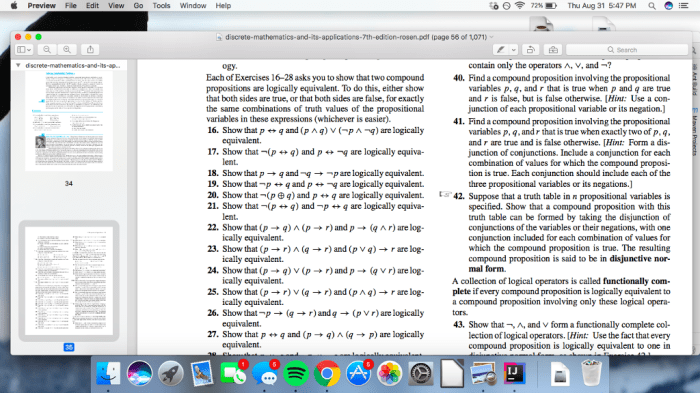
De Morgan’s Laws, initially explored in the context of set theory, find significant applications in Boolean Algebra, particularly in the realm of digital logic circuits. Boolean Algebra, a system of logic dealing with binary values (true or false, 1 or 0), forms the foundation for digital circuits. De Morgan’s Laws provide a powerful tool for simplifying and optimizing these circuits.
Application of De Morgan’s Laws in Digital Logic Circuits
De Morgan’s Laws are instrumental in simplifying and optimizing digital logic circuits. They allow us to express logic functions in different but equivalent forms, which can lead to more efficient and cost-effective circuit implementations.
Digital logic circuits are built using logic gates, which perform basic logical operations on binary inputs. These gates are represented by symbols and are fundamental building blocks of digital circuits. Common logic gates include:
* AND gate: Outputs 1 only if all inputs are 1.
* OR gate: Outputs 1 if at least one input is 1.
* NOT gate: Inverts the input, outputting 1 if the input is 0 and vice versa.
De Morgan’s Laws can be applied to these gates to express them in alternative forms using other gates. For instance, using De Morgan’s Laws, we can express an AND gate using OR gates and NOT gates, or vice versa.
Example of Simplifying a Logic Circuit Using De Morgan’s Laws
Consider a logic circuit with the following expression:
NOT (A AND B)
This expression represents a circuit with an AND gate followed by a NOT gate. Using De Morgan’s first law, we can rewrite this expression as:
NOT (A AND B) = (NOT A) OR (NOT B)
This equivalent expression represents a circuit with two NOT gates followed by an OR gate. This simplified circuit is equivalent to the original circuit in functionality but requires fewer gates, resulting in a more efficient design.
Impact of De Morgan’s Laws on Circuit Optimization and Efficiency
De Morgan’s Laws contribute significantly to circuit optimization and efficiency by:
* Reducing the number of gates: By expressing logic functions in different forms, De Morgan’s Laws allow us to simplify circuits, reducing the number of gates required. This translates to smaller circuit sizes, lower power consumption, and potentially lower cost.
* Minimizing circuit complexity: Simplifying logic expressions through De Morgan’s Laws makes the circuit design process more manageable. It allows for easier analysis, troubleshooting, and modification of the circuit.
* Enabling efficient circuit implementation: De Morgan’s Laws provide a framework for converting complex logic expressions into simpler, more efficient forms, enabling more practical and cost-effective implementations of digital circuits.
De Morgan’s Laws play a crucial role in the design and optimization of digital logic circuits, leading to more efficient, compact, and cost-effective implementations. Their applications extend beyond basic logic circuits, impacting various aspects of digital design, including computer architecture, embedded systems, and digital signal processing.
De Morgan’s Laws in Programming and Computer Science
De Morgan’s Laws, a fundamental concept in logic and set theory, find practical applications in programming and computer science, particularly in the realm of logical expressions. These laws provide a powerful tool for simplifying complex logical statements, optimizing code, and enhancing readability.
Applications of De Morgan’s Laws in Logical Expressions
De Morgan’s Laws are directly applicable to logical expressions, which are combinations of Boolean variables (true or false) connected by logical operators such as AND (&&), OR (||), and NOT (!). These laws offer a way to transform logical expressions, making them easier to understand and manipulate.
The first law states that the negation of a conjunction (AND) is equivalent to the disjunction (OR) of the negations of the individual propositions.
The second law states that the negation of a disjunction (OR) is equivalent to the conjunction (AND) of the negations of the individual propositions.
In programming languages, De Morgan’s Laws are used to rewrite logical expressions, simplifying them and often leading to more efficient code. For example, instead of checking if a condition is true and another condition is true, you can check if either condition is false.
Code Examples of De Morgan’s Laws
De Morgan’s Laws can be applied in various programming paradigms, including procedural, object-oriented, and functional programming. The following code examples demonstrate the application of De Morgan’s Laws in different programming languages.
Procedural Programming
// C++ code demonstrating De Morgan's Law bool condition1 = true; bool condition2 = false; // Original expression if (condition1 && condition2) // Code to execute if both conditions are true // Equivalent expression using De Morgan's Law if (!(condition1 || condition2)) // Code to execute if either condition is false
Object-Oriented Programming
// Java code demonstrating De Morgan's Law
class MyClass
public static void main(String[] args)
boolean condition1 = true;
boolean condition2 = false;
// Original expression
if (condition1 && condition2)
System.out.println("Both conditions are true");
// Equivalent expression using De Morgan's Law
if (!(condition1 || condition2))
System.out.println("Either condition is false");
Functional Programming
// JavaScript code demonstrating De Morgan's Law
const condition1 = true;
const condition2 = false;
// Original expression
if (condition1 && condition2)
console.log("Both conditions are true");
// Equivalent expression using De Morgan's Law
if (!(condition1 || condition2))
console.log("Either condition is false");
Benefits of Using De Morgan’s Laws
Utilizing De Morgan’s Laws in programming offers several advantages:
Code Optimization
De Morgan’s Laws can lead to more efficient code by simplifying logical expressions and reducing the number of operations required. This can be particularly beneficial in performance-critical applications.
Readability
By rewriting complex logical expressions, De Morgan’s Laws can improve code readability, making it easier for developers to understand and maintain.
Maintainability
Simplified logical expressions are often easier to modify and adapt, reducing the risk of introducing errors during code maintenance.
Error Prevention
Applying De Morgan’s Laws can help prevent errors by ensuring that logical expressions are correctly implemented and that their intended behavior is accurately reflected in the code.
De Morgan’s Laws in Other Fields
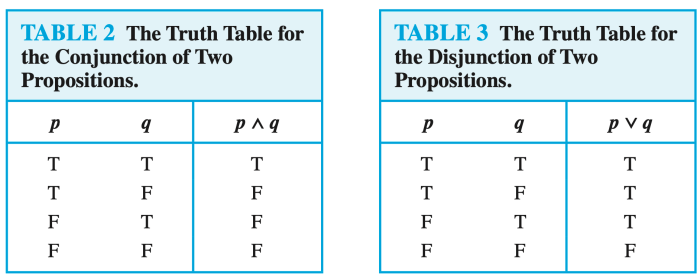
De Morgan’s Laws, while rooted in logic and set theory, have a profound impact on various other fields, influencing how we understand and solve problems in probability theory, statistics, and artificial intelligence. Their ability to simplify complex logical expressions and provide insights into the relationships between events and propositions makes them invaluable tools in these domains.
Applications in Probability Theory
De Morgan’s Laws play a crucial role in probability theory, particularly when dealing with the probabilities of complex events. They allow us to calculate the probability of the union or intersection of events by considering the probabilities of their complements.
For instance, consider two events, A and B, where A represents the event of “rolling a 6 on a die” and B represents the event of “rolling an even number.” The probability of event A is 1/6, and the probability of event B is 1/2. Using De Morgan’s Laws, we can calculate the probability of the event “not rolling a 6 and not rolling an even number” (the complement of the union of A and B).
The probability of the complement of the union of two events is equal to the product of the probabilities of the complements of the individual events.
In this case, the probability of not rolling a 6 is 5/6, and the probability of not rolling an even number is 1/2. Therefore, the probability of the event “not rolling a 6 and not rolling an even number” is (5/6) * (1/2) = 5/12.
Applications in Statistics
De Morgan’s Laws find applications in statistics, particularly in hypothesis testing and statistical inference. They are used to simplify the formulation of hypotheses and to derive the distribution of test statistics.
For example, consider a hypothesis test where we want to determine if the mean of a population is equal to a specific value. We can formulate the null hypothesis as “the mean is equal to the specific value” and the alternative hypothesis as “the mean is not equal to the specific value.” Using De Morgan’s Laws, we can express the alternative hypothesis as “the mean is less than the specific value or the mean is greater than the specific value.” This simplification allows us to perform the hypothesis test using a two-tailed test, which is more efficient than a one-tailed test.
Applications in Artificial Intelligence
De Morgan’s Laws have significant applications in artificial intelligence, particularly in the development of knowledge representation systems and reasoning engines. They are used to simplify logical expressions, which are often used to represent knowledge and perform reasoning tasks.
For example, consider a knowledge representation system that uses propositional logic to represent knowledge about a domain. The system may have a rule that states “If a person is a student and has a high GPA, then they are eligible for a scholarship.” Using De Morgan’s Laws, we can rewrite this rule as “If a person is not a student or does not have a high GPA, then they are not eligible for a scholarship.” This simplified rule is easier to understand and process by the reasoning engine.
Closure
De Morgan’s Law, a cornerstone of logic, empowers us to manipulate complex logical expressions with elegance and efficiency. Its applications extend far beyond the realm of mathematics, finding vital roles in computer science, programming, set theory, and even artificial intelligence. By understanding and applying these laws, we unlock the potential to simplify intricate problems, optimize algorithms, and enhance the clarity of logical reasoning. De Morgan’s Law stands as a testament to the power of logical principles, illuminating the interconnectedness of seemingly disparate concepts and offering a valuable tool for navigating the complexities of the logical world.
FAQ
What is the practical use of De Morgan’s Law in everyday life?
De Morgan’s Law finds practical applications in everyday decision-making. For example, when planning a trip, you might think: “I’ll go to the beach *only if* it’s sunny *and* not too crowded.” Applying De Morgan’s Law, this is equivalent to: “I won’t go to the beach if it’s not sunny *or* if it’s too crowded.” This demonstrates how the law helps us understand and express complex conditions in simpler terms.
Can De Morgan’s Law be applied to solve problems in probability?
Yes, De Morgan’s Law has applications in probability theory. It can be used to calculate the probability of an event not occurring, which is often easier than directly calculating the probability of the event occurring. For instance, if you want to know the probability of rolling a dice and getting a number that is not a 6, you can use De Morgan’s Law to calculate the probability of rolling a 6 and then subtract it from 1.
